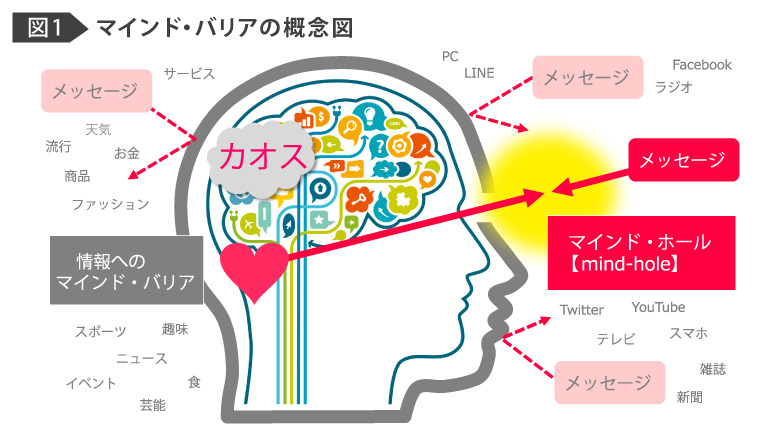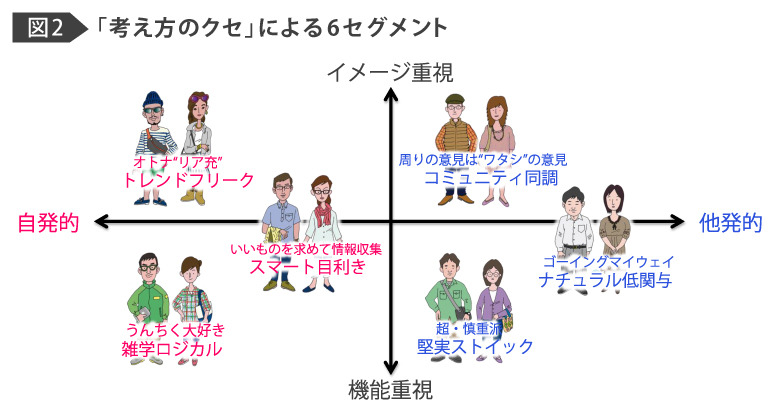Note: This website was automatically translated, so some terms or nuances may not be completely accurate.
Understanding Consumers Through Their "Thinking Habits" 6 Consumer Segments
Video Research Ltd.'s "Human Research Institute" leverages our vast consumer data and insights to study communication that resonates with consumers and to identify and solve communication challenges faced by companies.
Last November, our institute published 'Video Research Ltd. New Marketing Theory: Break Through the Mind Hole.' In this series, using the book as our subject, we will introduce how classifying increasingly diverse consumers into types based on their "thinking habits" actually allows for a simpler understanding and enables more effective approaches.

People have "thinking patterns"
"Thinking habits" refer to "characteristics of thought during information gathering and purchasing decisions." Focusing on these habits, our institute has developed new consumer segments*. Understanding someone's thinking habits reveals the media and communication message elements most likely to resonate with them.
*Segment: A group within a market (unspecified large number of people) sharing common consumer attributes (age, gender, occupation, values, etc.).
"Mind Barrier" and "Mind Hole"
Now, about the term "Mind Hole" in this book's title. Many of you are probably wondering, "What exactly is that?" "Mind Hole" is a term coined by our institute, alongside "Mind Barrier."
In modern society, the evolution of ICT has led to an overflow of diverse and massive amounts of information, creating a chaotic state. We call this state "Communication Chaos."
From the consumer's perspective, "Communication Chaos" can be visualized as shown in Figure 1. Consumers, surrounded by diverse media and an overwhelming flood of information, unknowingly shut out much of the information and messages they encounter.

This state can be described as the formation of a "Mind Barrier" against information, making it extremely difficult for messages to pass through and reach the individual.
Consumers unconsciously sort and select information. The information they choose is the information that has successfully passed through the "Mind Barrier." We named this passageway through which information passes the "Mind Hole." Getting information through the consumer's "Mind Hole" is crucial.
Six Segments Exist in "Thinking Habits"
Depending on the differences in consumers' "thinking habits," their ways of taking in information and choosing products differ, and naturally, the location of their "Mind Hole" also varies. Here, we introduce the characteristics of how information is taken in and products are chosen for each of the six segments (Figure 2).

They prioritize intuition and sensibility when making choices. They are sensitive to new things and trends, gathering information not only on things they are interested in but also on things they are not particularly interested in. They also have a strong desire to share information, often initiating conversations.
They love spec information like functionality and performance. They thoroughly gather information on everything and choose items that are "meaningful" or "logically sound." They gather information quickly and show interest in new things, but their clear selection criteria prevent them from being swayed by trends.
They pursue better items or brands rather than sticking to specific ones. Purchases only happen when both conditions are met: the item or brand is currently trending and also satisfies their functional requirements. However, once something meets their high standards, they actively share information about it with others.
Their choice is based on "public opinion," and they care about how others perceive them. They don't actively seek out new information or trends; instead, they notice them after they've gained some traction and adopt them to "avoid being left behind."
These cautious individuals absolutely avoid failure. They are meticulous planners with thorough future preparations. Frugal by nature, they avoid wasteful spending. They steer clear of new trends, choosing only what they know is reliable. Consequently, they favor established products or later-released, affordable alternatives that offer all necessary functions after the initial wave of popularity.
They don't particularly feel the importance of gathering information or have anxieties about being left behind by society. They lack clear personal selection criteria or distinct preferences, living their daily lives without much fuss. Since they aren't picky, they tend to choose items prominently displayed in stores.
How about it? Did you find the results convincing?
This book also introduces "specific keywords" that resonate with each segment as they pass through the "Mind Hole." Which type is most likely to be swayed by "Number One in Sales!"?! If you're interested, please give it a read.
Next time, we'll show you with concrete data how differences in "thinking habits" manifest as real-life disparities. Stay tuned.
Was this article helpful?